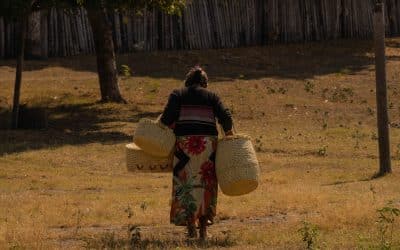This blog was originally published on countercurrents.org
By Souparna Lahiri*
Every year, 21st March is celebrated as the International Day of Forests, so designated by the United Nations to highlight the importance of forests. This year, the Food and Agriculture Organization (FAO) has announced the theme of “Forests and Energy”, calling forests “nature’s power house,” highlighting that forests are not anymore just energy providers for basic cooking and heating needs, but can power cars and airplanes through modern biofuels.
As fossil fuel supplies come under threat, industries are now looking towards forests as a source of so-called renewable, sustainable, and climate friendly energy.
Examples of such bioenergy include biofuel plantations like palm-oil, and wood- based bioenergy which is the burning of wood from forests or plantations to produce electricity. Often, real forests are cut, and not just ‘wood wastes’ as FAO and industry claim. The growth in this industry is driven by massive subsidies and wood is even being imported from forests across the world to bioenergy plants especially in the EU to meet renewable energy targets. Studies in fact point out that such bioenergy is not renewable or carbon neutral. A massive 40% of global renewable energy supply now comes from woodbased energy – much more than that of solar, hydroelectric, or wind.
A key question is, how will forests provide for such high energy demands being put on them, especially in the name of renewables? The growing trend in the Global South is a rise in monoculture tree plantations for biofuels, or wood. Biofuel plantations have already caused the clearing of rainforests and threatened animals and humans that depend on them.
At the heart of the problem is that the FAO has been wrongly defining plantations as forests, erroneously calling them “planted forests,” thereby allowing the latters replacement by the former. It has been over ten years now since a strong global campaign against FAO’s problematic forest definition began. The FAO definition considers forests to be basically just “a bunch of trees”, while ignoring other fundamental aspects of forests, including the fact that forests are biodiverse, capable of supporting a web of life with so many other life-forms, plants, animals, insects, fungi, as well as forest-dependent human communities. It is not an exaggeration when activists call monoculture plantations ‘green deserts’—they bear little resemblance to natural forests and are incapable of supporting the web of life that is so crucial to the planet. The FAO thus ignores the vital contribution of forests to natural processes that provide soil, water and oxygen.
FAO’s promotion of tree plantations is a boost to countries like India listed under the top ten countries in the world in terms of tree plantation development. Historically, the British Colonial forest administration had developed huge tracts of monoculture plantations for revenue extraction and this practice has been continued after independence with plantation development being part of the working plan of the forest departments. Since the 1960s there have been periodic protests against plantations by the forest communities where community agricultural lands and common lands were forcibly planted with trees. The practice of coupe cutting, where natural forests are felled only to be replaced with monoculture plantations, has off late, faced strong protests from forest communities.
The first decade of this century saw a policy boost towards jatropha plantation as a source of biofuel, especially in the central Indian state of Chhattisgarh where hundreds of thousands of acres of forest lands were forcibly planted with jatropha of whom, going by the official data, less than one fourth survived. In the process, agricultural lands, grazing land and forest commons were taken over by the overzealous forest department ignoring and clamping down on the rights of the forest dwellers as per the provisions of the Forest Rights Act, 2006. Recently, growing of oil palm plantations were observed in the forest department nurseries in Chhattisgarh, which is an ominous sign given the devastating impact of oil palm plantations in Indonesia.
India, as a policy matter, is on a plantation development spree with massive fund supporting the compensatory afforestation drive and the Green India Mission (GIM). With the enactment of the Compensatory Afforestation Fund Act 2016 (CAFA) more than $6 billion (INR 40,000 crore) is pumped into the forestry sector for afforestation programme in lieu of forest land diverted (read loss of forest land) for industrial projects. The fund is generated through the compensation paid by companies (read offsetting) for forest loss.
The GIM is a climate mitigation programme, part of India’s REDD+ scheme, with a budget of around $6.9 billion (Rs.46,000 crore) to cover 10 million hectares with monoculture plantations in the guise of eco-restoration and increase of forest cover.
India’s effort to increase forest cover and therefore to show an increase in carbon stock and carbon sequestration has now got a financial boost through sharing of tax benefits for the states with forest cover according to the recommendations of the 14th Finance Commission. An estimated INR55,000 ($8.3 billion) crore forest-based fiscal transfer is being envisaged, which is more than 24 times the annual budget allocation for the Ministry of Environment, Forests and Climate Change in 2016-17.
Behind these massive plantation programmes, primarily to increase forest cover, lies the blatant violation of the rights of the forest people in India, as enshrined in one of the most powerful legislations enacted in independent India – The Forest Rights Act, 2006. The Compensatory Afforestation Fund, accumulated by offsetting the cutting of forests due by industrial and development projects, facilitates a diversion of forests without settling rights of the forest communities. While the CAFA, in its implementation of the plantation programme has done away with the consent of the Gram Sabha (Village Council) in complete violation of the Forest Rights Act. Forest diversion for mega hydro-power projects and mining are cleared without the consent of the Gram Sabha.
GIM is implemented at the village level through Joint Forest Management (JFM) Committees controlled by the forest department thus undermining the Constitutional power of the Gram Sabhas and the rights of the forest dwellers.
FAO’s promotion of industrial plantations at a global scale will thus facilitate violation of the rights of the indigenous and local forest communities in countries of Asia, Africa and Latin America and benefit countries with massive monoculture plantations. The monoculture plantations, in turn will be the fertile ground to attract climate finance under REDD+ programme.
This year’s theme of “Forests and Energy” to celebrate the International Day of Forests on March 21, is, therefore, a clear threat to the forests, biodiversity of our Mother Earth and the forest communities the world over.
*Souparna Lahiri is currently a member of the All India Forum of Forest Movements and the Global Forest Coalition. He is a veteran of the forest movement in India. Souparna is an anti-carbon trade activist and has worked on exposing Clean Development Mechanism projects in India. He has also worked with communities resisting big hydro projects in north eastern India, monitored international financial institutions like the Asian Development Bank and its policies, worked on campaign for labor rights, defending human rights and rights and dignity of the street children in the past.
Email: souparna.lahiri@gmail.com




